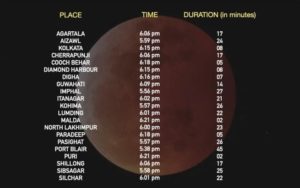Barak UpdatesHappeningsBreaking News
Super Blood Moon lunar eclipse’s partial phase to be visible for 22 minutes from Silchar on 26 May
The eclipse to be visible from Silchar at 6.01 PM IST

May 25: Watchers of the night sky are in for a treat this week with the arrival of what has been dubbed a Super Flower Blood Moon. The lengthy name is the result of a few astronomical phenomena coming together at once. The supermoon will be visible all over the world, and the full lunar eclipse will be visible in many parts of the world

According to the India Meteorological Department (IMD), a total eclipse of the Moon will occur on May 26, 2021. From India, just after moon rise, ending of partial phase of the eclipse will be visible for a short span of time from north eastern parts of India (except Sikkim), some parts of West Bengal, some coastal parts of Odisha and Andaman & Nicobar Islands.
 The eclipse will be visible in the region covering South America, North America, Asia, Australia, Antarctica, the Pacific Ocean and the Indian Ocean. The partial phase of the eclipse will begin on 26 May at 3.15 PM IST. The total phase will begin at 4.39 PM IST. The total phase will end at 4.58 PM IST. The partial phase will end at 6.23 PM IST.
The eclipse will be visible in the region covering South America, North America, Asia, Australia, Antarctica, the Pacific Ocean and the Indian Ocean. The partial phase of the eclipse will begin on 26 May at 3.15 PM IST. The total phase will begin at 4.39 PM IST. The total phase will end at 4.58 PM IST. The partial phase will end at 6.23 PM IST.
From India, just after moonrise, ending of partial phase of eclipse will be visible for a short span of time. The lunar eclipse’s partial phase will be visible for 22 minutes from Silchar on 26 May at 6.01 PM IST.
 The next lunar eclipse will be visible from India on November 19,2021. It will be a partial lunar eclipse. The ending of the partial phase of which will be visible for a very short span of time just after moon rise from extreme north eastern parts of Arunachal Pradesh and Assam.
The next lunar eclipse will be visible from India on November 19,2021. It will be a partial lunar eclipse. The ending of the partial phase of which will be visible for a very short span of time just after moon rise from extreme north eastern parts of Arunachal Pradesh and Assam.
Lunar eclipse occurs on a full moon day when the Earth comes in between the Sun and the Moon and when all the three objects are aligned. A total lunar eclipse will occur when the whole Moon comes under the umbral shadow of the Earth and the partial lunar eclipse occurs when only a part of the Moon comes under the umbral shadow of the Earth.




